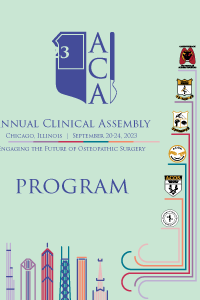Back
Introduction/Purpose: The internal thoracic artery (ITA) is a commonly used vessel in coronary artery bypass surgeries and other cardiac procedures. However, the characteristics of a posterolateral branch (PLB) of the ITA can cause complications during these surgeries, leading to increased morbidity and mortality rates. This research describes the anatomical variations of the ITA and any prominent PLB branches that could alter the flow of blood, leading to ischemia and other adverse outcomes post-surgery in men compared to women. By understanding the potential anatomical variations of the ITA, like a PLB artery, surgeons can take preventative measures to ensure successful outcomes for their patients.
Methods or Case Description: All cadaver specimens (n=64) were routinely dissected. Following excision of anterior chest plate, both ITAs and their proximolateral branches (PLB) were exposed. Digital calipers were used to measure vessel diameter. To address the curvilinearity of the thoracic cage, flexible rulers were used to measure length and curvilinear distance from sternum, both internally and externally, in the first three intercostal spaces (ICS). Additionally, PLB branching point angle was measured digitally via photography at the first ICS.
Outcomes: On average men have a longer PLB artery at 62.88mm compared to women at 44.86mm. This PLB artery also branches more perpendicular on the right side at a 93.1-degree angle, compared to the left side, which is more acute, at 78.7 degrees. Two male cadavers had bilateral origination of the PLB artery superior to the first rib. Out of the 15 PLBs found in total, four started in the infraclavicular space, five terminated in the second intercostal space, and two terminated in the third intercostal space.
Conclusion: Morphology of ITA and its branches may be more varied than previously described. Specific variants appear to present procedure-specific challenges and should be acknowledged when performing intrathoracic procedures in order to reduce post-procedural complications and improve patient outcomes. Knowledge of external measures may be more applicable.
ACOS 2023 Annual Clinical Assembly
Cardiothoracic Surgery
General Vascular Surgery
Podium Presentation - Cardiothoracic Surgery & General Vascular Surgery
Clinically Significant Morphology of the Internal Thoracic Artery Branches
Thursday, September 21, 2023
1:20 PM – 1:30 PM CT
Location: Denver - Houston - Kansas City, 5th Floor
- JM
Joey Marcuccilli
OMS-2
A.T. Still University
ATSU - Kirksville College of Osteopathic MedicineDisclosure(s): No financial relationships to disclose
Member Speaker(s)
Disclosure(s):
Joey Marcuccilli: No financial relationships to disclose
Learning Objectives:
- Upon completion, the participant will be understand the measurements of the aberrant branches of the internal thoracic artery.
- Upon completion, the participant will be able to understand the clinical significance of the aberrant branches of the internal thoracic artery.
- Upon completion, the participant will be able to determine where the aberrant artery of the internal thoracic artery should be located if it is present.
Methods or Case Description: All cadaver specimens (n=64) were routinely dissected. Following excision of anterior chest plate, both ITAs and their proximolateral branches (PLB) were exposed. Digital calipers were used to measure vessel diameter. To address the curvilinearity of the thoracic cage, flexible rulers were used to measure length and curvilinear distance from sternum, both internally and externally, in the first three intercostal spaces (ICS). Additionally, PLB branching point angle was measured digitally via photography at the first ICS.
Outcomes: On average men have a longer PLB artery at 62.88mm compared to women at 44.86mm. This PLB artery also branches more perpendicular on the right side at a 93.1-degree angle, compared to the left side, which is more acute, at 78.7 degrees. Two male cadavers had bilateral origination of the PLB artery superior to the first rib. Out of the 15 PLBs found in total, four started in the infraclavicular space, five terminated in the second intercostal space, and two terminated in the third intercostal space.
Conclusion: Morphology of ITA and its branches may be more varied than previously described. Specific variants appear to present procedure-specific challenges and should be acknowledged when performing intrathoracic procedures in order to reduce post-procedural complications and improve patient outcomes. Knowledge of external measures may be more applicable.

